Exploring the Intersection of Psychoanalysis and Historical Contexts
VerifiedAdded on 2020/06/03
|12
|4633
|187
AI Summary
Psychohistory is an interdisciplinary field that combines elements of psychology, particularly psychoanalysis, with the study of history. It seeks to understand not just what happened in historical contexts but also why individuals and societies behaved as they did, often influenced by unconscious motives and societal pressures. This exploration requires analyzing a wide range of sources, from traditional historical texts to psychological theories and case studies. Key figures like Sigmund Freud have significantly contributed to this field through concepts such as the Oedipus complex or the role of repression in shaping cultural narratives. The assignment will involve assessing seminal works within psychohistory, examining critiques and defenses of its methodologies, and exploring how it has evolved over time with contributions from scholars who have expanded its theoretical foundations. By integrating psychological theories into historical analysis, this field provides a deeper understanding of human behavior across different eras.
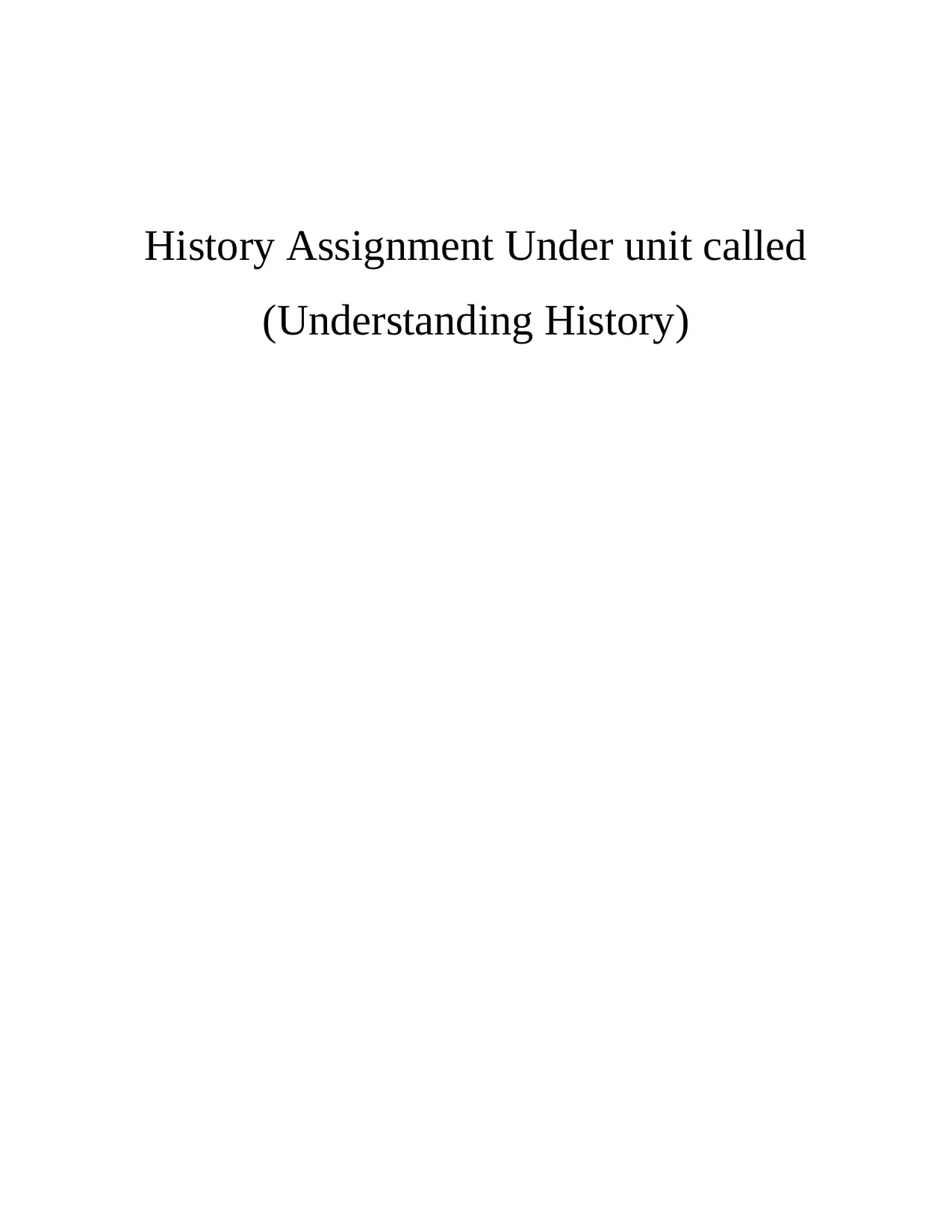
History Assignment Under unit called
(Understanding History)
(Understanding History)
Paraphrase This Document
Need a fresh take? Get an instant paraphrase of this document with our AI Paraphraser
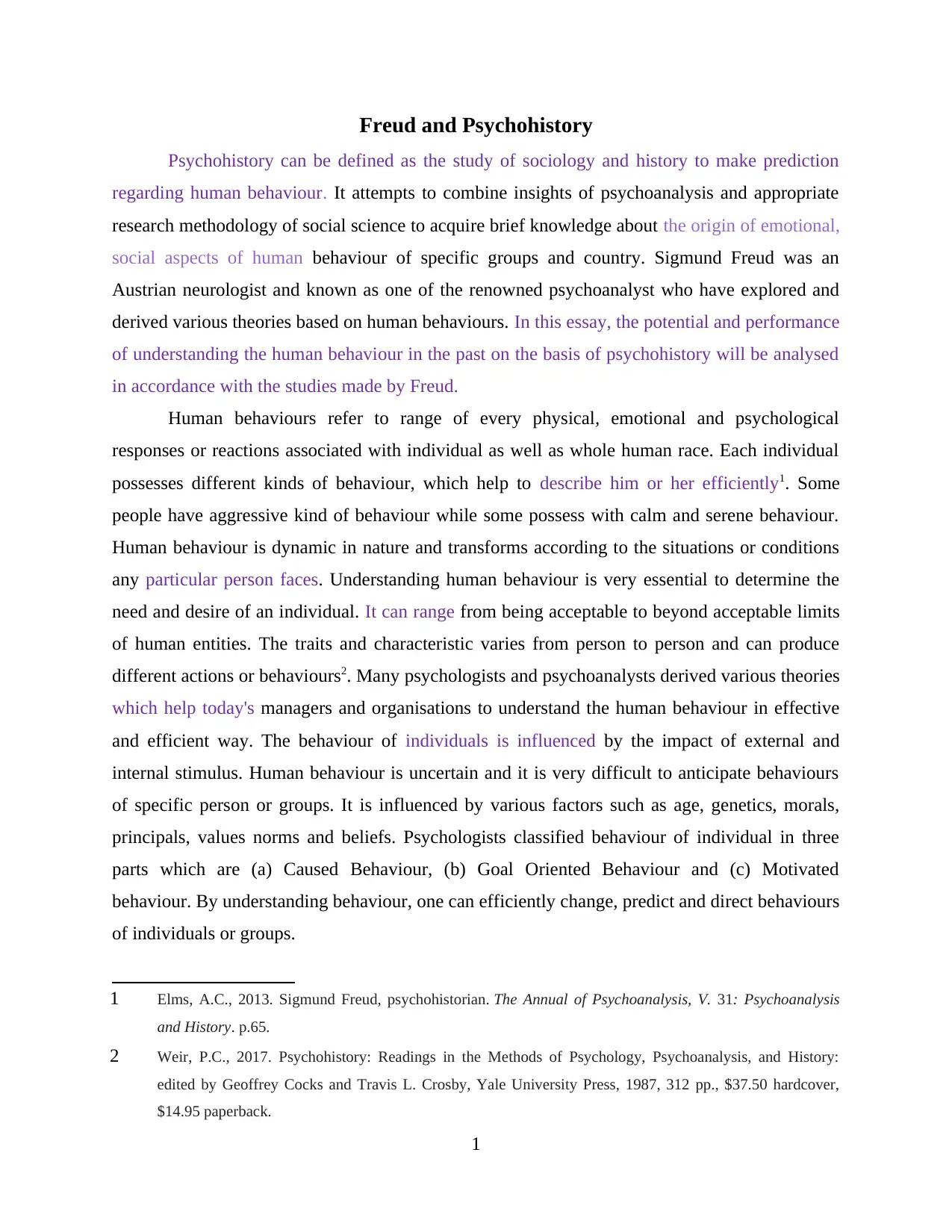
Freud and Psychohistory
Psychohistory can be defined as the study of sociology and history to make prediction
regarding human behaviour. It attempts to combine insights of psychoanalysis and appropriate
research methodology of social science to acquire brief knowledge about the origin of emotional,
social aspects of human behaviour of specific groups and country. Sigmund Freud was an
Austrian neurologist and known as one of the renowned psychoanalyst who have explored and
derived various theories based on human behaviours. In this essay, the potential and performance
of understanding the human behaviour in the past on the basis of psychohistory will be analysed
in accordance with the studies made by Freud.
Human behaviours refer to range of every physical, emotional and psychological
responses or reactions associated with individual as well as whole human race. Each individual
possesses different kinds of behaviour, which help to describe him or her efficiently1. Some
people have aggressive kind of behaviour while some possess with calm and serene behaviour.
Human behaviour is dynamic in nature and transforms according to the situations or conditions
any particular person faces. Understanding human behaviour is very essential to determine the
need and desire of an individual. It can range from being acceptable to beyond acceptable limits
of human entities. The traits and characteristic varies from person to person and can produce
different actions or behaviours2. Many psychologists and psychoanalysts derived various theories
which help today's managers and organisations to understand the human behaviour in effective
and efficient way. The behaviour of individuals is influenced by the impact of external and
internal stimulus. Human behaviour is uncertain and it is very difficult to anticipate behaviours
of specific person or groups. It is influenced by various factors such as age, genetics, morals,
principals, values norms and beliefs. Psychologists classified behaviour of individual in three
parts which are (a) Caused Behaviour, (b) Goal Oriented Behaviour and (c) Motivated
behaviour. By understanding behaviour, one can efficiently change, predict and direct behaviours
of individuals or groups.
1 Elms, A.C., 2013. Sigmund Freud, psychohistorian. The Annual of Psychoanalysis, V. 31: Psychoanalysis
and History. p.65.
2 Weir, P.C., 2017. Psychohistory: Readings in the Methods of Psychology, Psychoanalysis, and History:
edited by Geoffrey Cocks and Travis L. Crosby, Yale University Press, 1987, 312 pp., $37.50 hardcover,
$14.95 paperback.
1
Psychohistory can be defined as the study of sociology and history to make prediction
regarding human behaviour. It attempts to combine insights of psychoanalysis and appropriate
research methodology of social science to acquire brief knowledge about the origin of emotional,
social aspects of human behaviour of specific groups and country. Sigmund Freud was an
Austrian neurologist and known as one of the renowned psychoanalyst who have explored and
derived various theories based on human behaviours. In this essay, the potential and performance
of understanding the human behaviour in the past on the basis of psychohistory will be analysed
in accordance with the studies made by Freud.
Human behaviours refer to range of every physical, emotional and psychological
responses or reactions associated with individual as well as whole human race. Each individual
possesses different kinds of behaviour, which help to describe him or her efficiently1. Some
people have aggressive kind of behaviour while some possess with calm and serene behaviour.
Human behaviour is dynamic in nature and transforms according to the situations or conditions
any particular person faces. Understanding human behaviour is very essential to determine the
need and desire of an individual. It can range from being acceptable to beyond acceptable limits
of human entities. The traits and characteristic varies from person to person and can produce
different actions or behaviours2. Many psychologists and psychoanalysts derived various theories
which help today's managers and organisations to understand the human behaviour in effective
and efficient way. The behaviour of individuals is influenced by the impact of external and
internal stimulus. Human behaviour is uncertain and it is very difficult to anticipate behaviours
of specific person or groups. It is influenced by various factors such as age, genetics, morals,
principals, values norms and beliefs. Psychologists classified behaviour of individual in three
parts which are (a) Caused Behaviour, (b) Goal Oriented Behaviour and (c) Motivated
behaviour. By understanding behaviour, one can efficiently change, predict and direct behaviours
of individuals or groups.
1 Elms, A.C., 2013. Sigmund Freud, psychohistorian. The Annual of Psychoanalysis, V. 31: Psychoanalysis
and History. p.65.
2 Weir, P.C., 2017. Psychohistory: Readings in the Methods of Psychology, Psychoanalysis, and History:
edited by Geoffrey Cocks and Travis L. Crosby, Yale University Press, 1987, 312 pp., $37.50 hardcover,
$14.95 paperback.
1
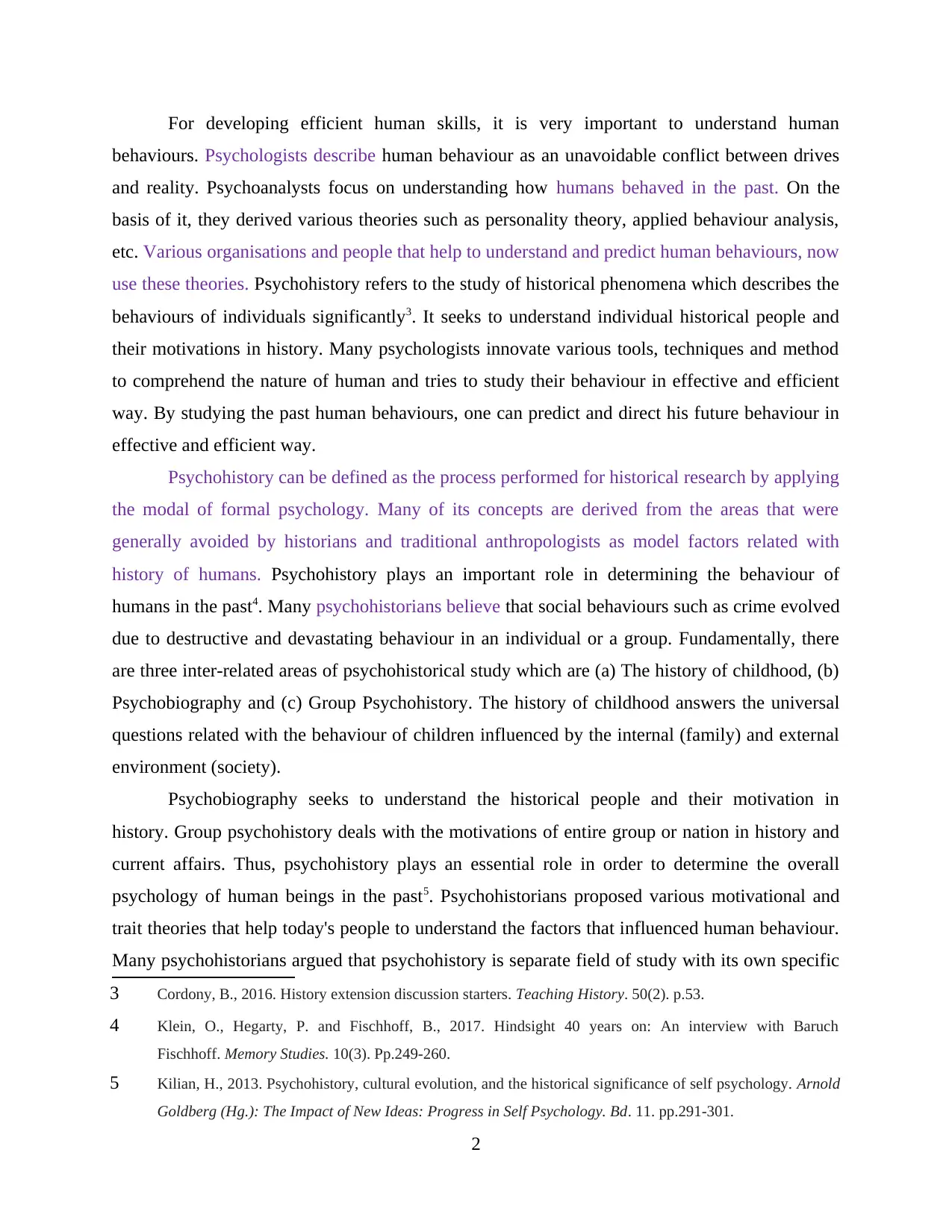
For developing efficient human skills, it is very important to understand human
behaviours. Psychologists describe human behaviour as an unavoidable conflict between drives
and reality. Psychoanalysts focus on understanding how humans behaved in the past. On the
basis of it, they derived various theories such as personality theory, applied behaviour analysis,
etc. Various organisations and people that help to understand and predict human behaviours, now
use these theories. Psychohistory refers to the study of historical phenomena which describes the
behaviours of individuals significantly3. It seeks to understand individual historical people and
their motivations in history. Many psychologists innovate various tools, techniques and method
to comprehend the nature of human and tries to study their behaviour in effective and efficient
way. By studying the past human behaviours, one can predict and direct his future behaviour in
effective and efficient way.
Psychohistory can be defined as the process performed for historical research by applying
the modal of formal psychology. Many of its concepts are derived from the areas that were
generally avoided by historians and traditional anthropologists as model factors related with
history of humans. Psychohistory plays an important role in determining the behaviour of
humans in the past4. Many psychohistorians believe that social behaviours such as crime evolved
due to destructive and devastating behaviour in an individual or a group. Fundamentally, there
are three inter-related areas of psychohistorical study which are (a) The history of childhood, (b)
Psychobiography and (c) Group Psychohistory. The history of childhood answers the universal
questions related with the behaviour of children influenced by the internal (family) and external
environment (society).
Psychobiography seeks to understand the historical people and their motivation in
history. Group psychohistory deals with the motivations of entire group or nation in history and
current affairs. Thus, psychohistory plays an essential role in order to determine the overall
psychology of human beings in the past5. Psychohistorians proposed various motivational and
trait theories that help today's people to understand the factors that influenced human behaviour.
Many psychohistorians argued that psychohistory is separate field of study with its own specific
3 Cordony, B., 2016. History extension discussion starters. Teaching History. 50(2). p.53.
4 Klein, O., Hegarty, P. and Fischhoff, B., 2017. Hindsight 40 years on: An interview with Baruch
Fischhoff. Memory Studies. 10(3). Pp.249-260.
5 Kilian, H., 2013. Psychohistory, cultural evolution, and the historical significance of self psychology. Arnold
Goldberg (Hg.): The Impact of New Ideas: Progress in Self Psychology. Bd. 11. pp.291-301.
2
behaviours. Psychologists describe human behaviour as an unavoidable conflict between drives
and reality. Psychoanalysts focus on understanding how humans behaved in the past. On the
basis of it, they derived various theories such as personality theory, applied behaviour analysis,
etc. Various organisations and people that help to understand and predict human behaviours, now
use these theories. Psychohistory refers to the study of historical phenomena which describes the
behaviours of individuals significantly3. It seeks to understand individual historical people and
their motivations in history. Many psychologists innovate various tools, techniques and method
to comprehend the nature of human and tries to study their behaviour in effective and efficient
way. By studying the past human behaviours, one can predict and direct his future behaviour in
effective and efficient way.
Psychohistory can be defined as the process performed for historical research by applying
the modal of formal psychology. Many of its concepts are derived from the areas that were
generally avoided by historians and traditional anthropologists as model factors related with
history of humans. Psychohistory plays an important role in determining the behaviour of
humans in the past4. Many psychohistorians believe that social behaviours such as crime evolved
due to destructive and devastating behaviour in an individual or a group. Fundamentally, there
are three inter-related areas of psychohistorical study which are (a) The history of childhood, (b)
Psychobiography and (c) Group Psychohistory. The history of childhood answers the universal
questions related with the behaviour of children influenced by the internal (family) and external
environment (society).
Psychobiography seeks to understand the historical people and their motivation in
history. Group psychohistory deals with the motivations of entire group or nation in history and
current affairs. Thus, psychohistory plays an essential role in order to determine the overall
psychology of human beings in the past5. Psychohistorians proposed various motivational and
trait theories that help today's people to understand the factors that influenced human behaviour.
Many psychohistorians argued that psychohistory is separate field of study with its own specific
3 Cordony, B., 2016. History extension discussion starters. Teaching History. 50(2). p.53.
4 Klein, O., Hegarty, P. and Fischhoff, B., 2017. Hindsight 40 years on: An interview with Baruch
Fischhoff. Memory Studies. 10(3). Pp.249-260.
5 Kilian, H., 2013. Psychohistory, cultural evolution, and the historical significance of self psychology. Arnold
Goldberg (Hg.): The Impact of New Ideas: Progress in Self Psychology. Bd. 11. pp.291-301.
2
⊘ This is a preview!⊘
Do you want full access?
Subscribe today to unlock all pages.

Trusted by 1+ million students worldwide
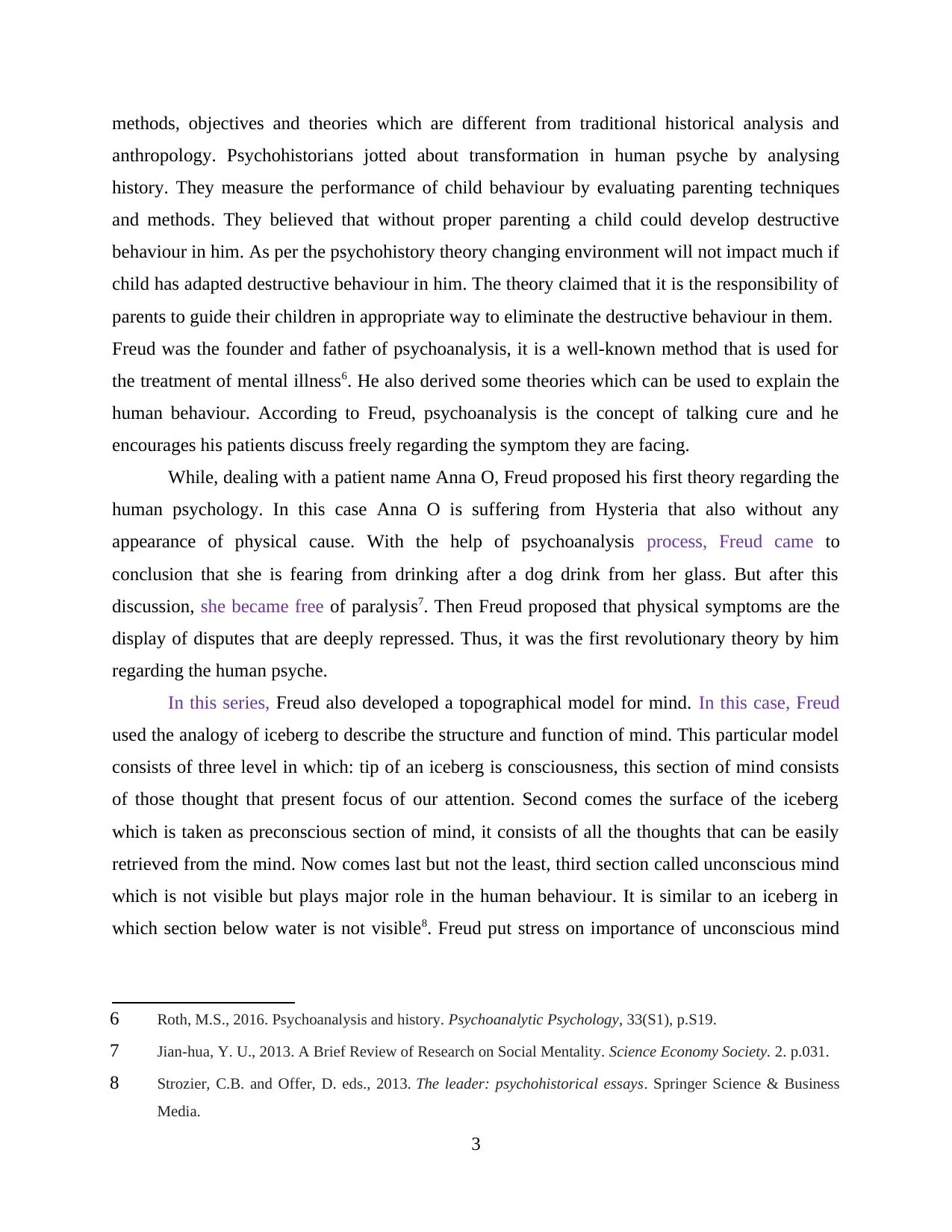
methods, objectives and theories which are different from traditional historical analysis and
anthropology. Psychohistorians jotted about transformation in human psyche by analysing
history. They measure the performance of child behaviour by evaluating parenting techniques
and methods. They believed that without proper parenting a child could develop destructive
behaviour in him. As per the psychohistory theory changing environment will not impact much if
child has adapted destructive behaviour in him. The theory claimed that it is the responsibility of
parents to guide their children in appropriate way to eliminate the destructive behaviour in them.
Freud was the founder and father of psychoanalysis, it is a well-known method that is used for
the treatment of mental illness6. He also derived some theories which can be used to explain the
human behaviour. According to Freud, psychoanalysis is the concept of talking cure and he
encourages his patients discuss freely regarding the symptom they are facing.
While, dealing with a patient name Anna O, Freud proposed his first theory regarding the
human psychology. In this case Anna O is suffering from Hysteria that also without any
appearance of physical cause. With the help of psychoanalysis process, Freud came to
conclusion that she is fearing from drinking after a dog drink from her glass. But after this
discussion, she became free of paralysis7. Then Freud proposed that physical symptoms are the
display of disputes that are deeply repressed. Thus, it was the first revolutionary theory by him
regarding the human psyche.
In this series, Freud also developed a topographical model for mind. In this case, Freud
used the analogy of iceberg to describe the structure and function of mind. This particular model
consists of three level in which: tip of an iceberg is consciousness, this section of mind consists
of those thought that present focus of our attention. Second comes the surface of the iceberg
which is taken as preconscious section of mind, it consists of all the thoughts that can be easily
retrieved from the mind. Now comes last but not the least, third section called unconscious mind
which is not visible but plays major role in the human behaviour. It is similar to an iceberg in
which section below water is not visible8. Freud put stress on importance of unconscious mind
6 Roth, M.S., 2016. Psychoanalysis and history. Psychoanalytic Psychology, 33(S1), p.S19.
7 Jian-hua, Y. U., 2013. A Brief Review of Research on Social Mentality. Science Economy Society. 2. p.031.
8 Strozier, C.B. and Offer, D. eds., 2013. The leader: psychohistorical essays. Springer Science & Business
Media.
3
anthropology. Psychohistorians jotted about transformation in human psyche by analysing
history. They measure the performance of child behaviour by evaluating parenting techniques
and methods. They believed that without proper parenting a child could develop destructive
behaviour in him. As per the psychohistory theory changing environment will not impact much if
child has adapted destructive behaviour in him. The theory claimed that it is the responsibility of
parents to guide their children in appropriate way to eliminate the destructive behaviour in them.
Freud was the founder and father of psychoanalysis, it is a well-known method that is used for
the treatment of mental illness6. He also derived some theories which can be used to explain the
human behaviour. According to Freud, psychoanalysis is the concept of talking cure and he
encourages his patients discuss freely regarding the symptom they are facing.
While, dealing with a patient name Anna O, Freud proposed his first theory regarding the
human psychology. In this case Anna O is suffering from Hysteria that also without any
appearance of physical cause. With the help of psychoanalysis process, Freud came to
conclusion that she is fearing from drinking after a dog drink from her glass. But after this
discussion, she became free of paralysis7. Then Freud proposed that physical symptoms are the
display of disputes that are deeply repressed. Thus, it was the first revolutionary theory by him
regarding the human psyche.
In this series, Freud also developed a topographical model for mind. In this case, Freud
used the analogy of iceberg to describe the structure and function of mind. This particular model
consists of three level in which: tip of an iceberg is consciousness, this section of mind consists
of those thought that present focus of our attention. Second comes the surface of the iceberg
which is taken as preconscious section of mind, it consists of all the thoughts that can be easily
retrieved from the mind. Now comes last but not the least, third section called unconscious mind
which is not visible but plays major role in the human behaviour. It is similar to an iceberg in
which section below water is not visible8. Freud put stress on importance of unconscious mind
6 Roth, M.S., 2016. Psychoanalysis and history. Psychoanalytic Psychology, 33(S1), p.S19.
7 Jian-hua, Y. U., 2013. A Brief Review of Research on Social Mentality. Science Economy Society. 2. p.031.
8 Strozier, C.B. and Offer, D. eds., 2013. The leader: psychohistorical essays. Springer Science & Business
Media.
3
Paraphrase This Document
Need a fresh take? Get an instant paraphrase of this document with our AI Paraphraser
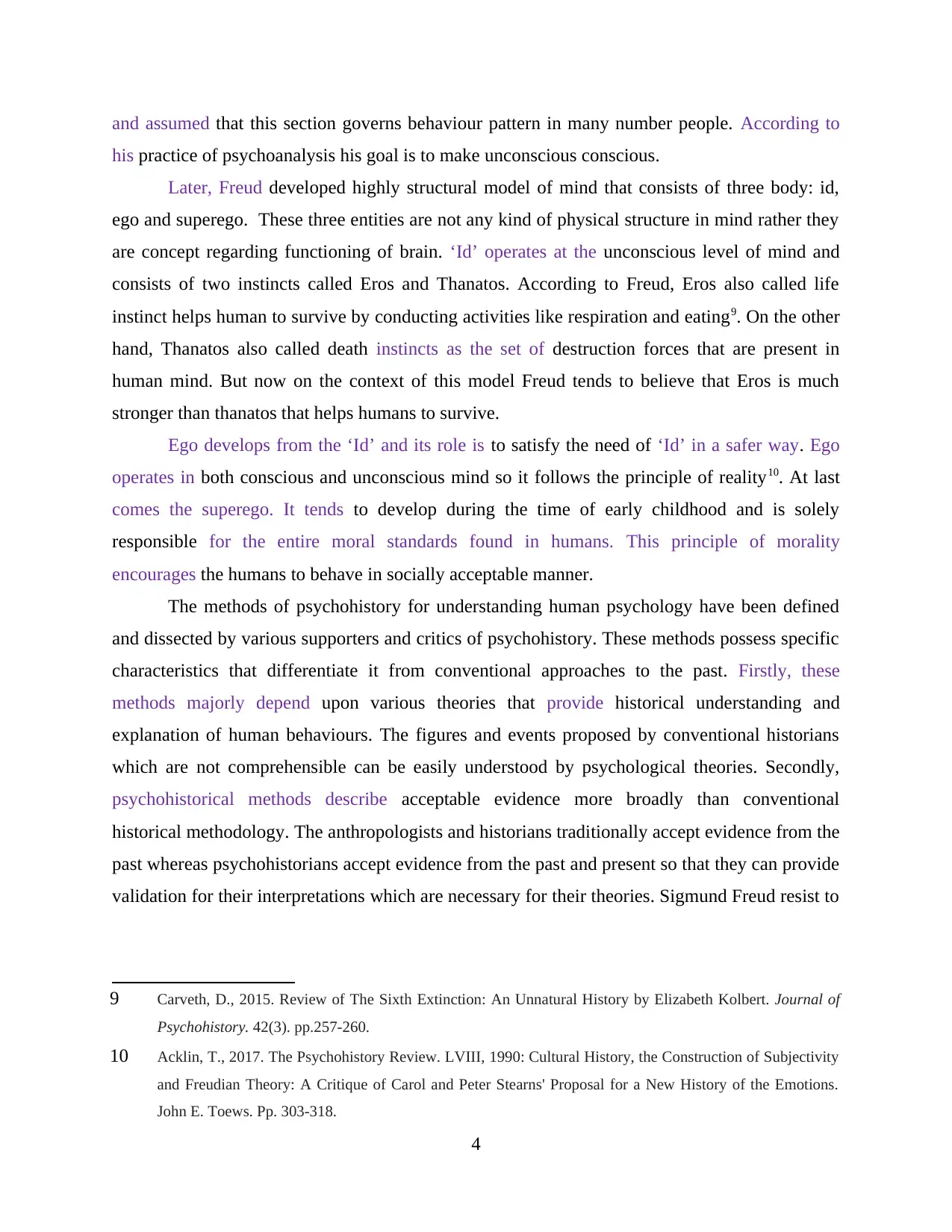
and assumed that this section governs behaviour pattern in many number people. According to
his practice of psychoanalysis his goal is to make unconscious conscious.
Later, Freud developed highly structural model of mind that consists of three body: id,
ego and superego. These three entities are not any kind of physical structure in mind rather they
are concept regarding functioning of brain. ‘Id’ operates at the unconscious level of mind and
consists of two instincts called Eros and Thanatos. According to Freud, Eros also called life
instinct helps human to survive by conducting activities like respiration and eating9. On the other
hand, Thanatos also called death instincts as the set of destruction forces that are present in
human mind. But now on the context of this model Freud tends to believe that Eros is much
stronger than thanatos that helps humans to survive.
Ego develops from the ‘Id’ and its role is to satisfy the need of ‘Id’ in a safer way. Ego
operates in both conscious and unconscious mind so it follows the principle of reality10. At last
comes the superego. It tends to develop during the time of early childhood and is solely
responsible for the entire moral standards found in humans. This principle of morality
encourages the humans to behave in socially acceptable manner.
The methods of psychohistory for understanding human psychology have been defined
and dissected by various supporters and critics of psychohistory. These methods possess specific
characteristics that differentiate it from conventional approaches to the past. Firstly, these
methods majorly depend upon various theories that provide historical understanding and
explanation of human behaviours. The figures and events proposed by conventional historians
which are not comprehensible can be easily understood by psychological theories. Secondly,
psychohistorical methods describe acceptable evidence more broadly than conventional
historical methodology. The anthropologists and historians traditionally accept evidence from the
past whereas psychohistorians accept evidence from the past and present so that they can provide
validation for their interpretations which are necessary for their theories. Sigmund Freud resist to
9 Carveth, D., 2015. Review of The Sixth Extinction: An Unnatural History by Elizabeth Kolbert. Journal of
Psychohistory. 42(3). pp.257-260.
10 Acklin, T., 2017. The Psychohistory Review. LVIII, 1990: Cultural History, the Construction of Subjectivity
and Freudian Theory: A Critique of Carol and Peter Stearns' Proposal for a New History of the Emotions.
John E. Toews. Pp. 303-318.
4
his practice of psychoanalysis his goal is to make unconscious conscious.
Later, Freud developed highly structural model of mind that consists of three body: id,
ego and superego. These three entities are not any kind of physical structure in mind rather they
are concept regarding functioning of brain. ‘Id’ operates at the unconscious level of mind and
consists of two instincts called Eros and Thanatos. According to Freud, Eros also called life
instinct helps human to survive by conducting activities like respiration and eating9. On the other
hand, Thanatos also called death instincts as the set of destruction forces that are present in
human mind. But now on the context of this model Freud tends to believe that Eros is much
stronger than thanatos that helps humans to survive.
Ego develops from the ‘Id’ and its role is to satisfy the need of ‘Id’ in a safer way. Ego
operates in both conscious and unconscious mind so it follows the principle of reality10. At last
comes the superego. It tends to develop during the time of early childhood and is solely
responsible for the entire moral standards found in humans. This principle of morality
encourages the humans to behave in socially acceptable manner.
The methods of psychohistory for understanding human psychology have been defined
and dissected by various supporters and critics of psychohistory. These methods possess specific
characteristics that differentiate it from conventional approaches to the past. Firstly, these
methods majorly depend upon various theories that provide historical understanding and
explanation of human behaviours. The figures and events proposed by conventional historians
which are not comprehensible can be easily understood by psychological theories. Secondly,
psychohistorical methods describe acceptable evidence more broadly than conventional
historical methodology. The anthropologists and historians traditionally accept evidence from the
past whereas psychohistorians accept evidence from the past and present so that they can provide
validation for their interpretations which are necessary for their theories. Sigmund Freud resist to
9 Carveth, D., 2015. Review of The Sixth Extinction: An Unnatural History by Elizabeth Kolbert. Journal of
Psychohistory. 42(3). pp.257-260.
10 Acklin, T., 2017. The Psychohistory Review. LVIII, 1990: Cultural History, the Construction of Subjectivity
and Freudian Theory: A Critique of Carol and Peter Stearns' Proposal for a New History of the Emotions.
John E. Toews. Pp. 303-318.
4
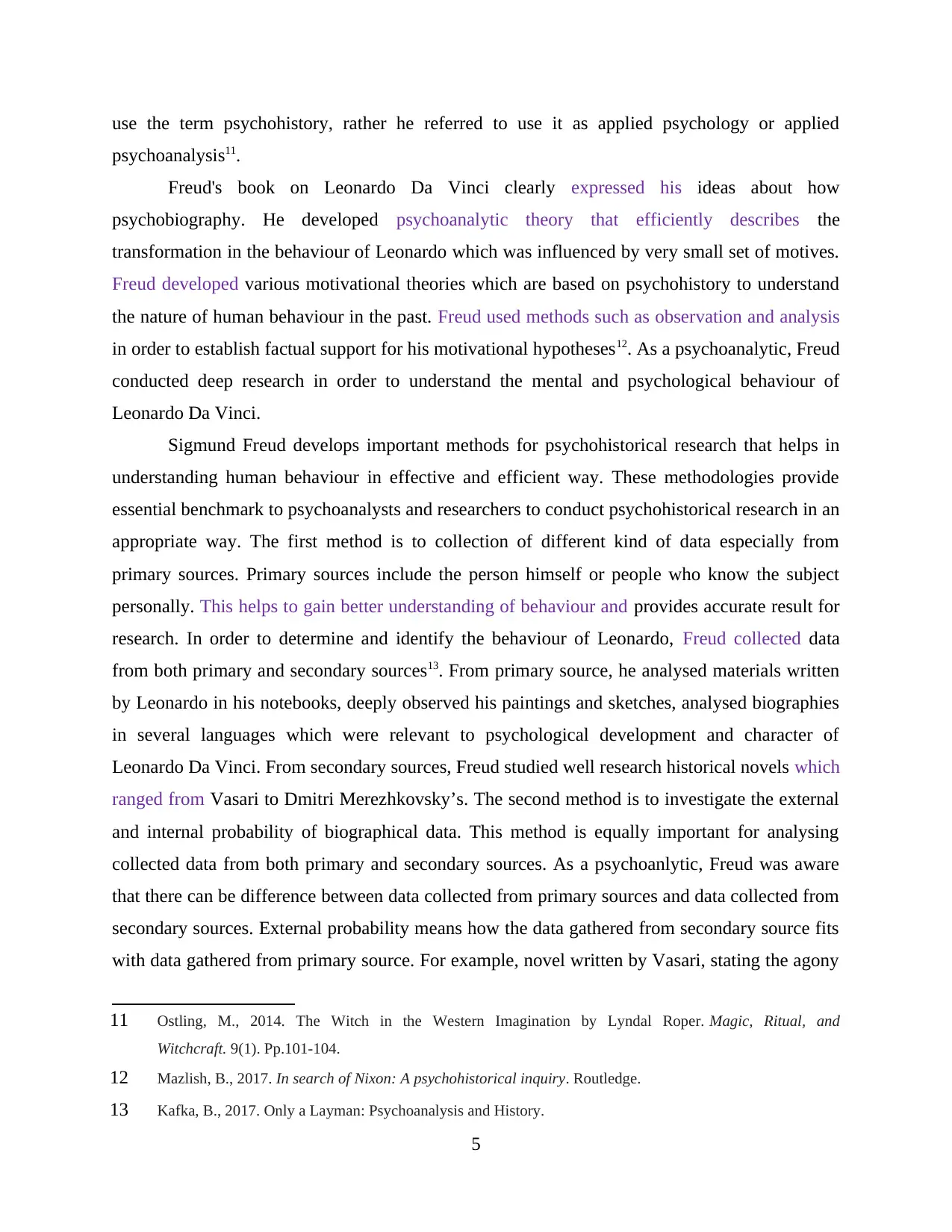
use the term psychohistory, rather he referred to use it as applied psychology or applied
psychoanalysis11.
Freud's book on Leonardo Da Vinci clearly expressed his ideas about how
psychobiography. He developed psychoanalytic theory that efficiently describes the
transformation in the behaviour of Leonardo which was influenced by very small set of motives.
Freud developed various motivational theories which are based on psychohistory to understand
the nature of human behaviour in the past. Freud used methods such as observation and analysis
in order to establish factual support for his motivational hypotheses12. As a psychoanalytic, Freud
conducted deep research in order to understand the mental and psychological behaviour of
Leonardo Da Vinci.
Sigmund Freud develops important methods for psychohistorical research that helps in
understanding human behaviour in effective and efficient way. These methodologies provide
essential benchmark to psychoanalysts and researchers to conduct psychohistorical research in an
appropriate way. The first method is to collection of different kind of data especially from
primary sources. Primary sources include the person himself or people who know the subject
personally. This helps to gain better understanding of behaviour and provides accurate result for
research. In order to determine and identify the behaviour of Leonardo, Freud collected data
from both primary and secondary sources13. From primary source, he analysed materials written
by Leonardo in his notebooks, deeply observed his paintings and sketches, analysed biographies
in several languages which were relevant to psychological development and character of
Leonardo Da Vinci. From secondary sources, Freud studied well research historical novels which
ranged from Vasari to Dmitri Merezhkovsky’s. The second method is to investigate the external
and internal probability of biographical data. This method is equally important for analysing
collected data from both primary and secondary sources. As a psychoanlytic, Freud was aware
that there can be difference between data collected from primary sources and data collected from
secondary sources. External probability means how the data gathered from secondary source fits
with data gathered from primary source. For example, novel written by Vasari, stating the agony
11 Ostling, M., 2014. The Witch in the Western Imagination by Lyndal Roper. Magic, Ritual, and
Witchcraft. 9(1). Pp.101-104.
12 Mazlish, B., 2017. In search of Nixon: A psychohistorical inquiry. Routledge.
13 Kafka, B., 2017. Only a Layman: Psychoanalysis and History.
5
psychoanalysis11.
Freud's book on Leonardo Da Vinci clearly expressed his ideas about how
psychobiography. He developed psychoanalytic theory that efficiently describes the
transformation in the behaviour of Leonardo which was influenced by very small set of motives.
Freud developed various motivational theories which are based on psychohistory to understand
the nature of human behaviour in the past. Freud used methods such as observation and analysis
in order to establish factual support for his motivational hypotheses12. As a psychoanalytic, Freud
conducted deep research in order to understand the mental and psychological behaviour of
Leonardo Da Vinci.
Sigmund Freud develops important methods for psychohistorical research that helps in
understanding human behaviour in effective and efficient way. These methodologies provide
essential benchmark to psychoanalysts and researchers to conduct psychohistorical research in an
appropriate way. The first method is to collection of different kind of data especially from
primary sources. Primary sources include the person himself or people who know the subject
personally. This helps to gain better understanding of behaviour and provides accurate result for
research. In order to determine and identify the behaviour of Leonardo, Freud collected data
from both primary and secondary sources13. From primary source, he analysed materials written
by Leonardo in his notebooks, deeply observed his paintings and sketches, analysed biographies
in several languages which were relevant to psychological development and character of
Leonardo Da Vinci. From secondary sources, Freud studied well research historical novels which
ranged from Vasari to Dmitri Merezhkovsky’s. The second method is to investigate the external
and internal probability of biographical data. This method is equally important for analysing
collected data from both primary and secondary sources. As a psychoanlytic, Freud was aware
that there can be difference between data collected from primary sources and data collected from
secondary sources. External probability means how the data gathered from secondary source fits
with data gathered from primary source. For example, novel written by Vasari, stating the agony
11 Ostling, M., 2014. The Witch in the Western Imagination by Lyndal Roper. Magic, Ritual, and
Witchcraft. 9(1). Pp.101-104.
12 Mazlish, B., 2017. In search of Nixon: A psychohistorical inquiry. Routledge.
13 Kafka, B., 2017. Only a Layman: Psychoanalysis and History.
5
⊘ This is a preview!⊘
Do you want full access?
Subscribe today to unlock all pages.

Trusted by 1+ million students worldwide
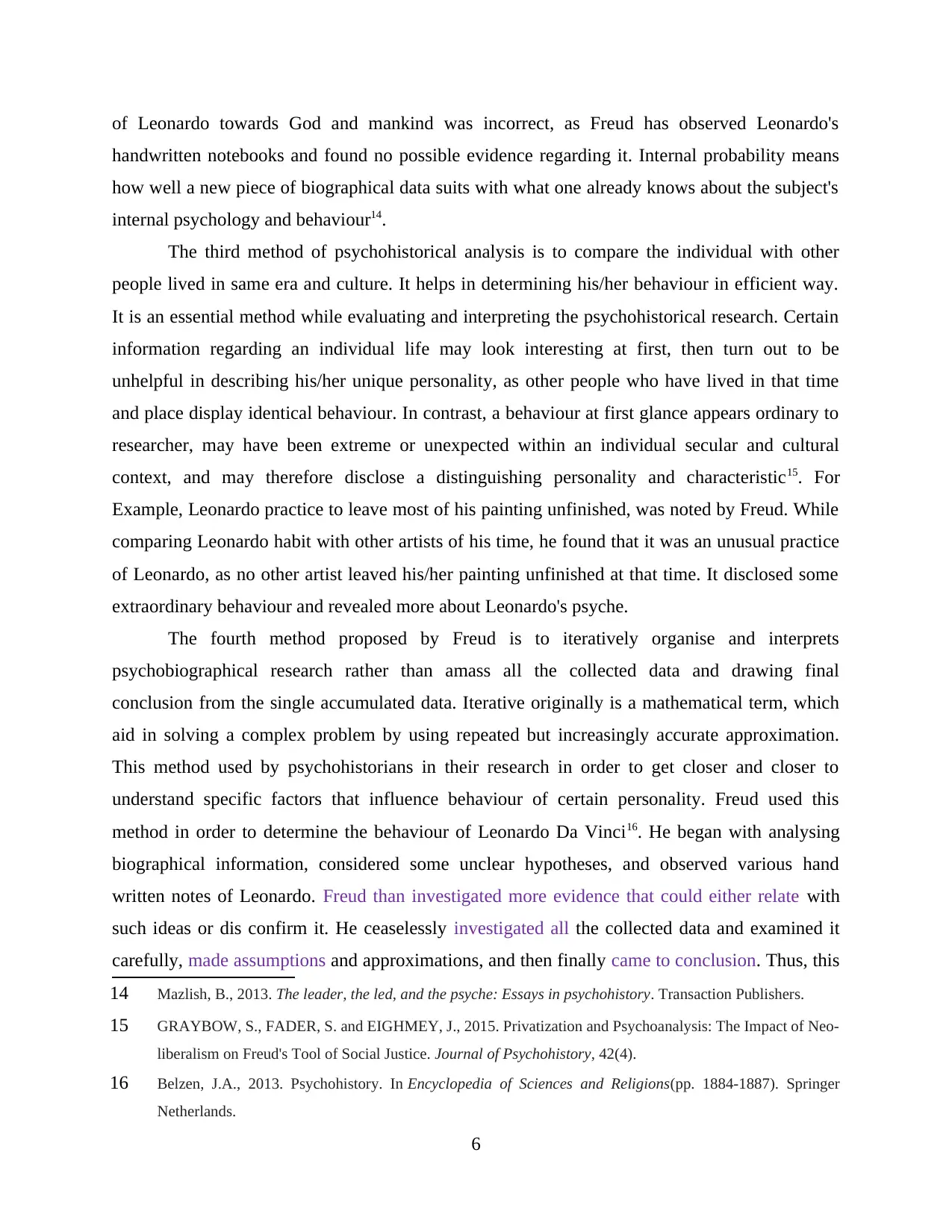
of Leonardo towards God and mankind was incorrect, as Freud has observed Leonardo's
handwritten notebooks and found no possible evidence regarding it. Internal probability means
how well a new piece of biographical data suits with what one already knows about the subject's
internal psychology and behaviour14.
The third method of psychohistorical analysis is to compare the individual with other
people lived in same era and culture. It helps in determining his/her behaviour in efficient way.
It is an essential method while evaluating and interpreting the psychohistorical research. Certain
information regarding an individual life may look interesting at first, then turn out to be
unhelpful in describing his/her unique personality, as other people who have lived in that time
and place display identical behaviour. In contrast, a behaviour at first glance appears ordinary to
researcher, may have been extreme or unexpected within an individual secular and cultural
context, and may therefore disclose a distinguishing personality and characteristic15. For
Example, Leonardo practice to leave most of his painting unfinished, was noted by Freud. While
comparing Leonardo habit with other artists of his time, he found that it was an unusual practice
of Leonardo, as no other artist leaved his/her painting unfinished at that time. It disclosed some
extraordinary behaviour and revealed more about Leonardo's psyche.
The fourth method proposed by Freud is to iteratively organise and interprets
psychobiographical research rather than amass all the collected data and drawing final
conclusion from the single accumulated data. Iterative originally is a mathematical term, which
aid in solving a complex problem by using repeated but increasingly accurate approximation.
This method used by psychohistorians in their research in order to get closer and closer to
understand specific factors that influence behaviour of certain personality. Freud used this
method in order to determine the behaviour of Leonardo Da Vinci16. He began with analysing
biographical information, considered some unclear hypotheses, and observed various hand
written notes of Leonardo. Freud than investigated more evidence that could either relate with
such ideas or dis confirm it. He ceaselessly investigated all the collected data and examined it
carefully, made assumptions and approximations, and then finally came to conclusion. Thus, this
14 Mazlish, B., 2013. The leader, the led, and the psyche: Essays in psychohistory. Transaction Publishers.
15 GRAYBOW, S., FADER, S. and EIGHMEY, J., 2015. Privatization and Psychoanalysis: The Impact of Neo-
liberalism on Freud's Tool of Social Justice. Journal of Psychohistory, 42(4).
16 Belzen, J.A., 2013. Psychohistory. In Encyclopedia of Sciences and Religions(pp. 1884-1887). Springer
Netherlands.
6
handwritten notebooks and found no possible evidence regarding it. Internal probability means
how well a new piece of biographical data suits with what one already knows about the subject's
internal psychology and behaviour14.
The third method of psychohistorical analysis is to compare the individual with other
people lived in same era and culture. It helps in determining his/her behaviour in efficient way.
It is an essential method while evaluating and interpreting the psychohistorical research. Certain
information regarding an individual life may look interesting at first, then turn out to be
unhelpful in describing his/her unique personality, as other people who have lived in that time
and place display identical behaviour. In contrast, a behaviour at first glance appears ordinary to
researcher, may have been extreme or unexpected within an individual secular and cultural
context, and may therefore disclose a distinguishing personality and characteristic15. For
Example, Leonardo practice to leave most of his painting unfinished, was noted by Freud. While
comparing Leonardo habit with other artists of his time, he found that it was an unusual practice
of Leonardo, as no other artist leaved his/her painting unfinished at that time. It disclosed some
extraordinary behaviour and revealed more about Leonardo's psyche.
The fourth method proposed by Freud is to iteratively organise and interprets
psychobiographical research rather than amass all the collected data and drawing final
conclusion from the single accumulated data. Iterative originally is a mathematical term, which
aid in solving a complex problem by using repeated but increasingly accurate approximation.
This method used by psychohistorians in their research in order to get closer and closer to
understand specific factors that influence behaviour of certain personality. Freud used this
method in order to determine the behaviour of Leonardo Da Vinci16. He began with analysing
biographical information, considered some unclear hypotheses, and observed various hand
written notes of Leonardo. Freud than investigated more evidence that could either relate with
such ideas or dis confirm it. He ceaselessly investigated all the collected data and examined it
carefully, made assumptions and approximations, and then finally came to conclusion. Thus, this
14 Mazlish, B., 2013. The leader, the led, and the psyche: Essays in psychohistory. Transaction Publishers.
15 GRAYBOW, S., FADER, S. and EIGHMEY, J., 2015. Privatization and Psychoanalysis: The Impact of Neo-
liberalism on Freud's Tool of Social Justice. Journal of Psychohistory, 42(4).
16 Belzen, J.A., 2013. Psychohistory. In Encyclopedia of Sciences and Religions(pp. 1884-1887). Springer
Netherlands.
6
Paraphrase This Document
Need a fresh take? Get an instant paraphrase of this document with our AI Paraphraser
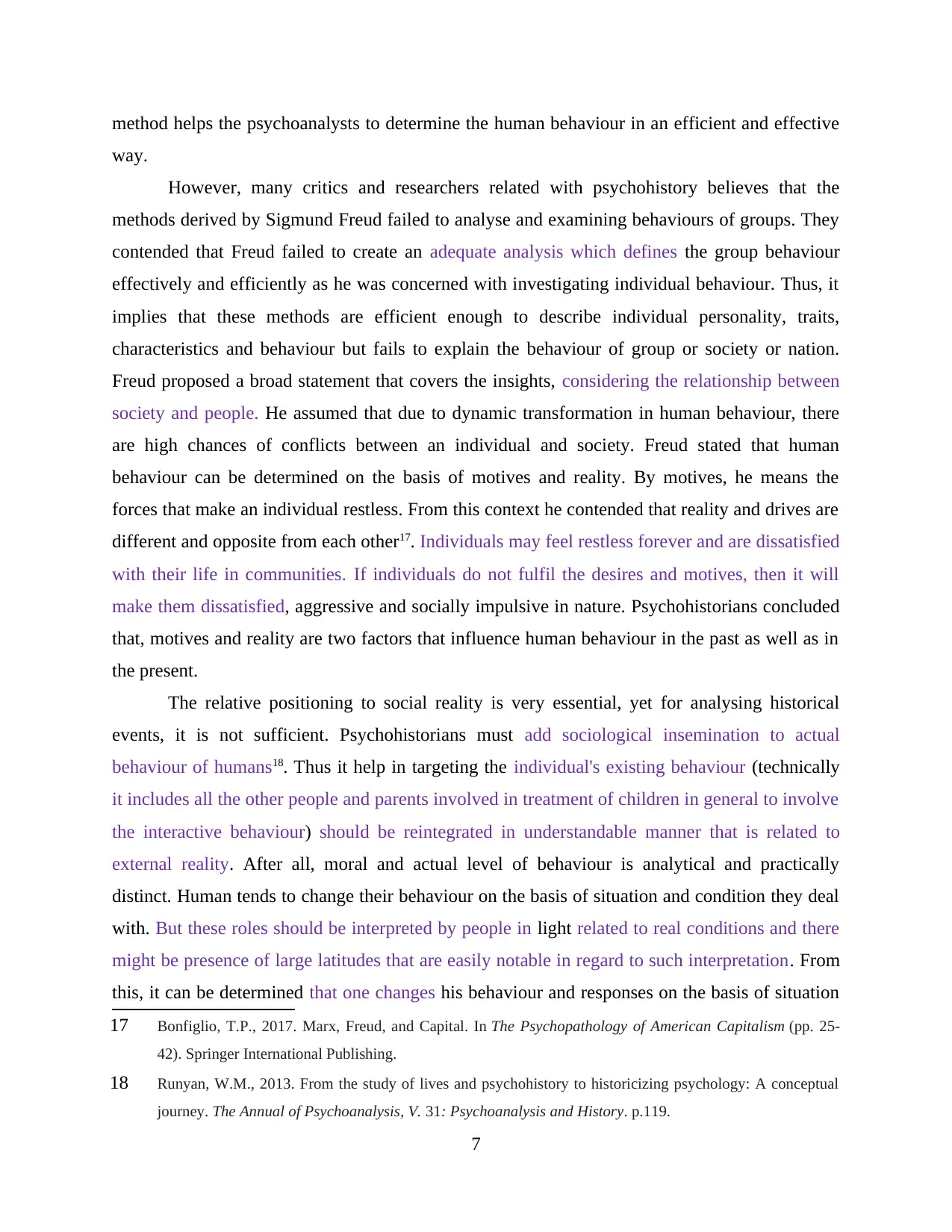
method helps the psychoanalysts to determine the human behaviour in an efficient and effective
way.
However, many critics and researchers related with psychohistory believes that the
methods derived by Sigmund Freud failed to analyse and examining behaviours of groups. They
contended that Freud failed to create an adequate analysis which defines the group behaviour
effectively and efficiently as he was concerned with investigating individual behaviour. Thus, it
implies that these methods are efficient enough to describe individual personality, traits,
characteristics and behaviour but fails to explain the behaviour of group or society or nation.
Freud proposed a broad statement that covers the insights, considering the relationship between
society and people. He assumed that due to dynamic transformation in human behaviour, there
are high chances of conflicts between an individual and society. Freud stated that human
behaviour can be determined on the basis of motives and reality. By motives, he means the
forces that make an individual restless. From this context he contended that reality and drives are
different and opposite from each other17. Individuals may feel restless forever and are dissatisfied
with their life in communities. If individuals do not fulfil the desires and motives, then it will
make them dissatisfied, aggressive and socially impulsive in nature. Psychohistorians concluded
that, motives and reality are two factors that influence human behaviour in the past as well as in
the present.
The relative positioning to social reality is very essential, yet for analysing historical
events, it is not sufficient. Psychohistorians must add sociological insemination to actual
behaviour of humans18. Thus it help in targeting the individual's existing behaviour (technically
it includes all the other people and parents involved in treatment of children in general to involve
the interactive behaviour) should be reintegrated in understandable manner that is related to
external reality. After all, moral and actual level of behaviour is analytical and practically
distinct. Human tends to change their behaviour on the basis of situation and condition they deal
with. But these roles should be interpreted by people in light related to real conditions and there
might be presence of large latitudes that are easily notable in regard to such interpretation. From
this, it can be determined that one changes his behaviour and responses on the basis of situation
17 Bonfiglio, T.P., 2017. Marx, Freud, and Capital. In The Psychopathology of American Capitalism (pp. 25-
42). Springer International Publishing.
18 Runyan, W.M., 2013. From the study of lives and psychohistory to historicizing psychology: A conceptual
journey. The Annual of Psychoanalysis, V. 31: Psychoanalysis and History. p.119.
7
way.
However, many critics and researchers related with psychohistory believes that the
methods derived by Sigmund Freud failed to analyse and examining behaviours of groups. They
contended that Freud failed to create an adequate analysis which defines the group behaviour
effectively and efficiently as he was concerned with investigating individual behaviour. Thus, it
implies that these methods are efficient enough to describe individual personality, traits,
characteristics and behaviour but fails to explain the behaviour of group or society or nation.
Freud proposed a broad statement that covers the insights, considering the relationship between
society and people. He assumed that due to dynamic transformation in human behaviour, there
are high chances of conflicts between an individual and society. Freud stated that human
behaviour can be determined on the basis of motives and reality. By motives, he means the
forces that make an individual restless. From this context he contended that reality and drives are
different and opposite from each other17. Individuals may feel restless forever and are dissatisfied
with their life in communities. If individuals do not fulfil the desires and motives, then it will
make them dissatisfied, aggressive and socially impulsive in nature. Psychohistorians concluded
that, motives and reality are two factors that influence human behaviour in the past as well as in
the present.
The relative positioning to social reality is very essential, yet for analysing historical
events, it is not sufficient. Psychohistorians must add sociological insemination to actual
behaviour of humans18. Thus it help in targeting the individual's existing behaviour (technically
it includes all the other people and parents involved in treatment of children in general to involve
the interactive behaviour) should be reintegrated in understandable manner that is related to
external reality. After all, moral and actual level of behaviour is analytical and practically
distinct. Human tends to change their behaviour on the basis of situation and condition they deal
with. But these roles should be interpreted by people in light related to real conditions and there
might be presence of large latitudes that are easily notable in regard to such interpretation. From
this, it can be determined that one changes his behaviour and responses on the basis of situation
17 Bonfiglio, T.P., 2017. Marx, Freud, and Capital. In The Psychopathology of American Capitalism (pp. 25-
42). Springer International Publishing.
18 Runyan, W.M., 2013. From the study of lives and psychohistory to historicizing psychology: A conceptual
journey. The Annual of Psychoanalysis, V. 31: Psychoanalysis and History. p.119.
7
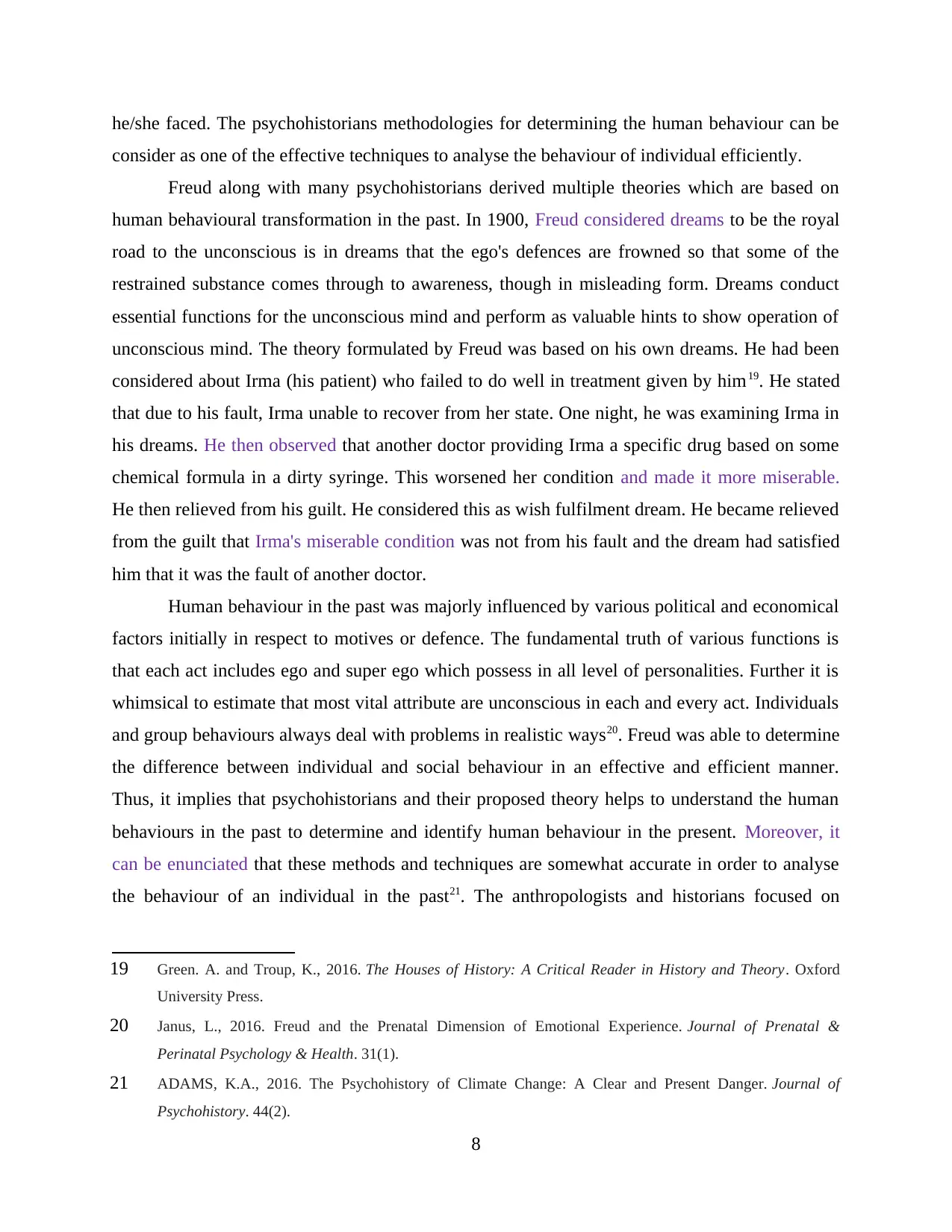
he/she faced. The psychohistorians methodologies for determining the human behaviour can be
consider as one of the effective techniques to analyse the behaviour of individual efficiently.
Freud along with many psychohistorians derived multiple theories which are based on
human behavioural transformation in the past. In 1900, Freud considered dreams to be the royal
road to the unconscious is in dreams that the ego's defences are frowned so that some of the
restrained substance comes through to awareness, though in misleading form. Dreams conduct
essential functions for the unconscious mind and perform as valuable hints to show operation of
unconscious mind. The theory formulated by Freud was based on his own dreams. He had been
considered about Irma (his patient) who failed to do well in treatment given by him19. He stated
that due to his fault, Irma unable to recover from her state. One night, he was examining Irma in
his dreams. He then observed that another doctor providing Irma a specific drug based on some
chemical formula in a dirty syringe. This worsened her condition and made it more miserable.
He then relieved from his guilt. He considered this as wish fulfilment dream. He became relieved
from the guilt that Irma's miserable condition was not from his fault and the dream had satisfied
him that it was the fault of another doctor.
Human behaviour in the past was majorly influenced by various political and economical
factors initially in respect to motives or defence. The fundamental truth of various functions is
that each act includes ego and super ego which possess in all level of personalities. Further it is
whimsical to estimate that most vital attribute are unconscious in each and every act. Individuals
and group behaviours always deal with problems in realistic ways20. Freud was able to determine
the difference between individual and social behaviour in an effective and efficient manner.
Thus, it implies that psychohistorians and their proposed theory helps to understand the human
behaviours in the past to determine and identify human behaviour in the present. Moreover, it
can be enunciated that these methods and techniques are somewhat accurate in order to analyse
the behaviour of an individual in the past21. The anthropologists and historians focused on
19 Green. A. and Troup, K., 2016. The Houses of History: A Critical Reader in History and Theory. Oxford
University Press.
20 Janus, L., 2016. Freud and the Prenatal Dimension of Emotional Experience. Journal of Prenatal &
Perinatal Psychology & Health. 31(1).
21 ADAMS, K.A., 2016. The Psychohistory of Climate Change: A Clear and Present Danger. Journal of
Psychohistory. 44(2).
8
consider as one of the effective techniques to analyse the behaviour of individual efficiently.
Freud along with many psychohistorians derived multiple theories which are based on
human behavioural transformation in the past. In 1900, Freud considered dreams to be the royal
road to the unconscious is in dreams that the ego's defences are frowned so that some of the
restrained substance comes through to awareness, though in misleading form. Dreams conduct
essential functions for the unconscious mind and perform as valuable hints to show operation of
unconscious mind. The theory formulated by Freud was based on his own dreams. He had been
considered about Irma (his patient) who failed to do well in treatment given by him19. He stated
that due to his fault, Irma unable to recover from her state. One night, he was examining Irma in
his dreams. He then observed that another doctor providing Irma a specific drug based on some
chemical formula in a dirty syringe. This worsened her condition and made it more miserable.
He then relieved from his guilt. He considered this as wish fulfilment dream. He became relieved
from the guilt that Irma's miserable condition was not from his fault and the dream had satisfied
him that it was the fault of another doctor.
Human behaviour in the past was majorly influenced by various political and economical
factors initially in respect to motives or defence. The fundamental truth of various functions is
that each act includes ego and super ego which possess in all level of personalities. Further it is
whimsical to estimate that most vital attribute are unconscious in each and every act. Individuals
and group behaviours always deal with problems in realistic ways20. Freud was able to determine
the difference between individual and social behaviour in an effective and efficient manner.
Thus, it implies that psychohistorians and their proposed theory helps to understand the human
behaviours in the past to determine and identify human behaviour in the present. Moreover, it
can be enunciated that these methods and techniques are somewhat accurate in order to analyse
the behaviour of an individual in the past21. The anthropologists and historians focused on
19 Green. A. and Troup, K., 2016. The Houses of History: A Critical Reader in History and Theory. Oxford
University Press.
20 Janus, L., 2016. Freud and the Prenatal Dimension of Emotional Experience. Journal of Prenatal &
Perinatal Psychology & Health. 31(1).
21 ADAMS, K.A., 2016. The Psychohistory of Climate Change: A Clear and Present Danger. Journal of
Psychohistory. 44(2).
8
⊘ This is a preview!⊘
Do you want full access?
Subscribe today to unlock all pages.

Trusted by 1+ million students worldwide
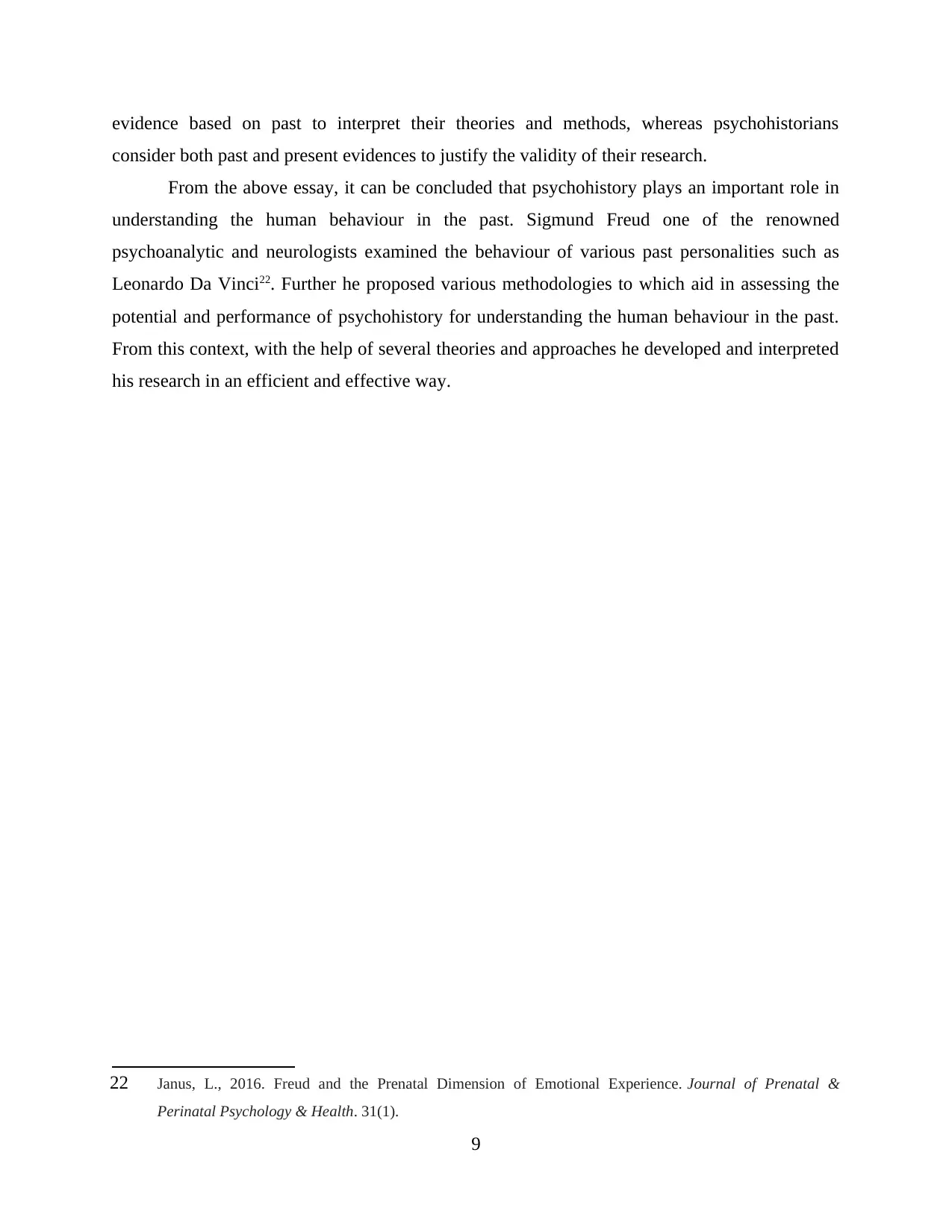
evidence based on past to interpret their theories and methods, whereas psychohistorians
consider both past and present evidences to justify the validity of their research.
From the above essay, it can be concluded that psychohistory plays an important role in
understanding the human behaviour in the past. Sigmund Freud one of the renowned
psychoanalytic and neurologists examined the behaviour of various past personalities such as
Leonardo Da Vinci22. Further he proposed various methodologies to which aid in assessing the
potential and performance of psychohistory for understanding the human behaviour in the past.
From this context, with the help of several theories and approaches he developed and interpreted
his research in an efficient and effective way.
22 Janus, L., 2016. Freud and the Prenatal Dimension of Emotional Experience. Journal of Prenatal &
Perinatal Psychology & Health. 31(1).
9
consider both past and present evidences to justify the validity of their research.
From the above essay, it can be concluded that psychohistory plays an important role in
understanding the human behaviour in the past. Sigmund Freud one of the renowned
psychoanalytic and neurologists examined the behaviour of various past personalities such as
Leonardo Da Vinci22. Further he proposed various methodologies to which aid in assessing the
potential and performance of psychohistory for understanding the human behaviour in the past.
From this context, with the help of several theories and approaches he developed and interpreted
his research in an efficient and effective way.
22 Janus, L., 2016. Freud and the Prenatal Dimension of Emotional Experience. Journal of Prenatal &
Perinatal Psychology & Health. 31(1).
9
Paraphrase This Document
Need a fresh take? Get an instant paraphrase of this document with our AI Paraphraser
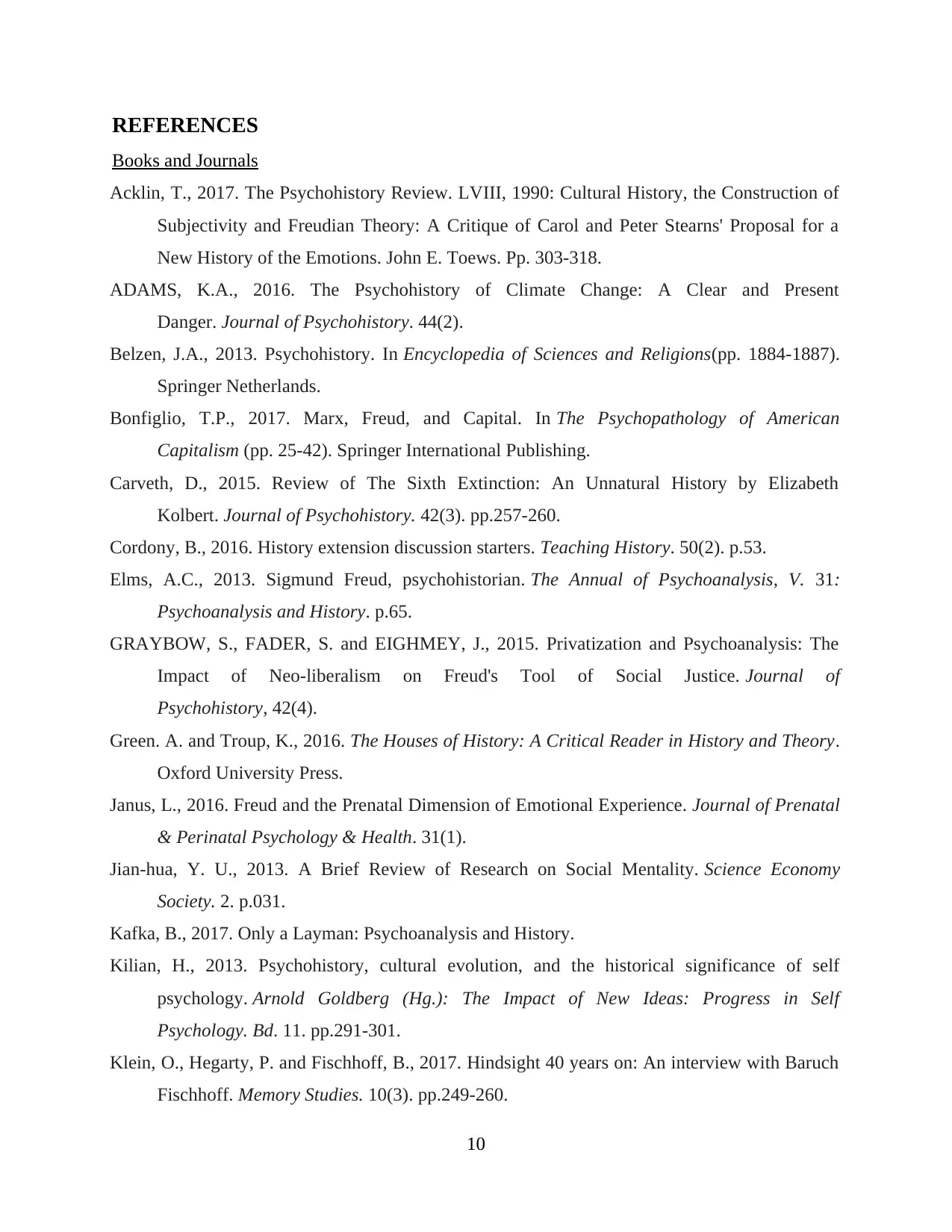
REFERENCES
Books and Journals
Acklin, T., 2017. The Psychohistory Review. LVIII, 1990: Cultural History, the Construction of
Subjectivity and Freudian Theory: A Critique of Carol and Peter Stearns' Proposal for a
New History of the Emotions. John E. Toews. Pp. 303-318.
ADAMS, K.A., 2016. The Psychohistory of Climate Change: A Clear and Present
Danger. Journal of Psychohistory. 44(2).
Belzen, J.A., 2013. Psychohistory. In Encyclopedia of Sciences and Religions(pp. 1884-1887).
Springer Netherlands.
Bonfiglio, T.P., 2017. Marx, Freud, and Capital. In The Psychopathology of American
Capitalism (pp. 25-42). Springer International Publishing.
Carveth, D., 2015. Review of The Sixth Extinction: An Unnatural History by Elizabeth
Kolbert. Journal of Psychohistory. 42(3). pp.257-260.
Cordony, B., 2016. History extension discussion starters. Teaching History. 50(2). p.53.
Elms, A.C., 2013. Sigmund Freud, psychohistorian. The Annual of Psychoanalysis, V. 31:
Psychoanalysis and History. p.65.
GRAYBOW, S., FADER, S. and EIGHMEY, J., 2015. Privatization and Psychoanalysis: The
Impact of Neo-liberalism on Freud's Tool of Social Justice. Journal of
Psychohistory, 42(4).
Green. A. and Troup, K., 2016. The Houses of History: A Critical Reader in History and Theory.
Oxford University Press.
Janus, L., 2016. Freud and the Prenatal Dimension of Emotional Experience. Journal of Prenatal
& Perinatal Psychology & Health. 31(1).
Jian-hua, Y. U., 2013. A Brief Review of Research on Social Mentality. Science Economy
Society. 2. p.031.
Kafka, B., 2017. Only a Layman: Psychoanalysis and History.
Kilian, H., 2013. Psychohistory, cultural evolution, and the historical significance of self
psychology. Arnold Goldberg (Hg.): The Impact of New Ideas: Progress in Self
Psychology. Bd. 11. pp.291-301.
Klein, O., Hegarty, P. and Fischhoff, B., 2017. Hindsight 40 years on: An interview with Baruch
Fischhoff. Memory Studies. 10(3). pp.249-260.
10
Books and Journals
Acklin, T., 2017. The Psychohistory Review. LVIII, 1990: Cultural History, the Construction of
Subjectivity and Freudian Theory: A Critique of Carol and Peter Stearns' Proposal for a
New History of the Emotions. John E. Toews. Pp. 303-318.
ADAMS, K.A., 2016. The Psychohistory of Climate Change: A Clear and Present
Danger. Journal of Psychohistory. 44(2).
Belzen, J.A., 2013. Psychohistory. In Encyclopedia of Sciences and Religions(pp. 1884-1887).
Springer Netherlands.
Bonfiglio, T.P., 2017. Marx, Freud, and Capital. In The Psychopathology of American
Capitalism (pp. 25-42). Springer International Publishing.
Carveth, D., 2015. Review of The Sixth Extinction: An Unnatural History by Elizabeth
Kolbert. Journal of Psychohistory. 42(3). pp.257-260.
Cordony, B., 2016. History extension discussion starters. Teaching History. 50(2). p.53.
Elms, A.C., 2013. Sigmund Freud, psychohistorian. The Annual of Psychoanalysis, V. 31:
Psychoanalysis and History. p.65.
GRAYBOW, S., FADER, S. and EIGHMEY, J., 2015. Privatization and Psychoanalysis: The
Impact of Neo-liberalism on Freud's Tool of Social Justice. Journal of
Psychohistory, 42(4).
Green. A. and Troup, K., 2016. The Houses of History: A Critical Reader in History and Theory.
Oxford University Press.
Janus, L., 2016. Freud and the Prenatal Dimension of Emotional Experience. Journal of Prenatal
& Perinatal Psychology & Health. 31(1).
Jian-hua, Y. U., 2013. A Brief Review of Research on Social Mentality. Science Economy
Society. 2. p.031.
Kafka, B., 2017. Only a Layman: Psychoanalysis and History.
Kilian, H., 2013. Psychohistory, cultural evolution, and the historical significance of self
psychology. Arnold Goldberg (Hg.): The Impact of New Ideas: Progress in Self
Psychology. Bd. 11. pp.291-301.
Klein, O., Hegarty, P. and Fischhoff, B., 2017. Hindsight 40 years on: An interview with Baruch
Fischhoff. Memory Studies. 10(3). pp.249-260.
10
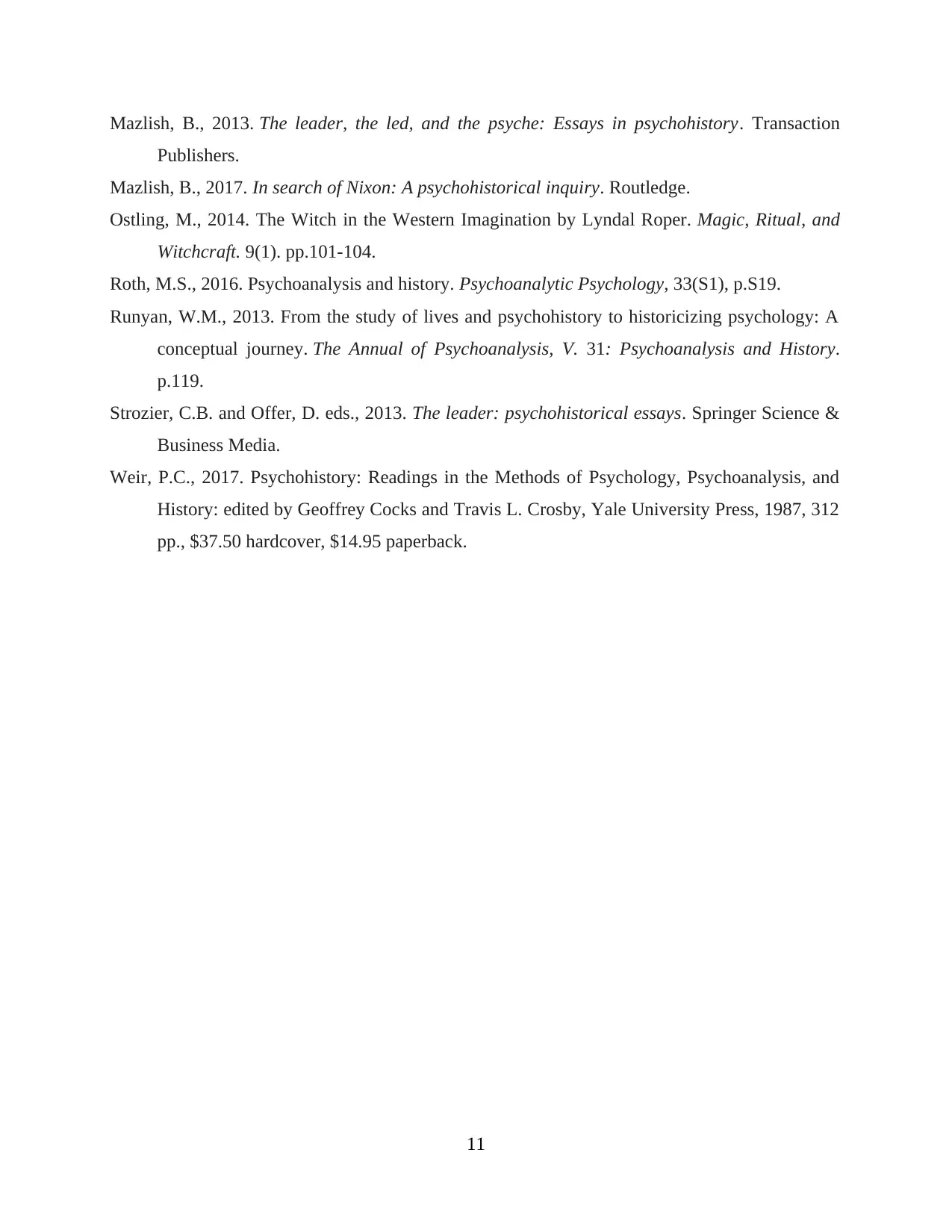
Mazlish, B., 2013. The leader, the led, and the psyche: Essays in psychohistory. Transaction
Publishers.
Mazlish, B., 2017. In search of Nixon: A psychohistorical inquiry. Routledge.
Ostling, M., 2014. The Witch in the Western Imagination by Lyndal Roper. Magic, Ritual, and
Witchcraft. 9(1). pp.101-104.
Roth, M.S., 2016. Psychoanalysis and history. Psychoanalytic Psychology, 33(S1), p.S19.
Runyan, W.M., 2013. From the study of lives and psychohistory to historicizing psychology: A
conceptual journey. The Annual of Psychoanalysis, V. 31: Psychoanalysis and History.
p.119.
Strozier, C.B. and Offer, D. eds., 2013. The leader: psychohistorical essays. Springer Science &
Business Media.
Weir, P.C., 2017. Psychohistory: Readings in the Methods of Psychology, Psychoanalysis, and
History: edited by Geoffrey Cocks and Travis L. Crosby, Yale University Press, 1987, 312
pp., $37.50 hardcover, $14.95 paperback.
11
Publishers.
Mazlish, B., 2017. In search of Nixon: A psychohistorical inquiry. Routledge.
Ostling, M., 2014. The Witch in the Western Imagination by Lyndal Roper. Magic, Ritual, and
Witchcraft. 9(1). pp.101-104.
Roth, M.S., 2016. Psychoanalysis and history. Psychoanalytic Psychology, 33(S1), p.S19.
Runyan, W.M., 2013. From the study of lives and psychohistory to historicizing psychology: A
conceptual journey. The Annual of Psychoanalysis, V. 31: Psychoanalysis and History.
p.119.
Strozier, C.B. and Offer, D. eds., 2013. The leader: psychohistorical essays. Springer Science &
Business Media.
Weir, P.C., 2017. Psychohistory: Readings in the Methods of Psychology, Psychoanalysis, and
History: edited by Geoffrey Cocks and Travis L. Crosby, Yale University Press, 1987, 312
pp., $37.50 hardcover, $14.95 paperback.
11
⊘ This is a preview!⊘
Do you want full access?
Subscribe today to unlock all pages.

Trusted by 1+ million students worldwide
1 out of 12
Related Documents
Your All-in-One AI-Powered Toolkit for Academic Success.
+13062052269
info@desklib.com
Available 24*7 on WhatsApp / Email
![[object Object]](/_next/static/media/star-bottom.7253800d.svg)
Unlock your academic potential
Copyright © 2020–2025 A2Z Services. All Rights Reserved. Developed and managed by ZUCOL.




